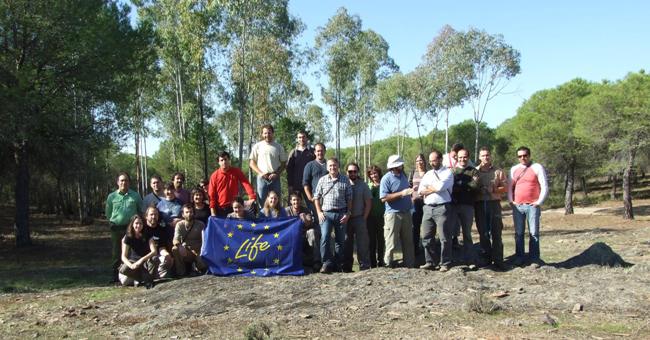Actions of environmental education, awareness and disclosure
Public Participation
Promotion of Natura 2000 Network
Actions of environmental education, awareness and disclosure
Workshop “Artificial nests in the conservation of Black Vulture and other arboreal birds of prey”
Organized by CEAI and LPN in the scope of the Project, this technical workshop occurred in the 20th and 21st October 2010 and was attended by about 30 people, representing several entities and projects, both Portuguese and Spanish.
The first day was dedicated to the presentation of 8 papers on this issue, by some of the experts present, followed by its discussion. The second day of the workshop was dedicated to practice and consisted in the construction of an artificial nest for Black Vulture in the proximities of the Biological Station of Garducho, for demonstration of the techniques and materials used in the construction of this kind of structures. The platform of the nest was kindly supplied by Consejería de Medio Ambiente da Junta de Andalucía, and consisted of three adjustable columns of iron, that form the basis and support the structure of the nest, and a metallic basket that will turn out to be the nest. The columns of iron that form the structure of support are fixed to the soil using metallic spikes and stays parallel to the trunk of the tree, supporting the basket that stays at the same height as the top of the tree canopy. The implementation of the structure requires a technician with training and material for climbing and is concluded with the collocation of plant materials, including sticks and branches from bushes forming the nest. This nest platform will remain installed for purposes of environmental education (field visits with local schools) and demonstration.
With this workshop it was possible to exchange experiences and acquire the necessary knowledge to accomplish with success the conservation action of ‘Construction of artificial nests for Black Vulture’.
The
abstracts’ book and the
papers of this workshop are available in ‘Documentation’.

Public Participation
Monitoring of changes in the attitudes towards the conservation of the Iberian Lynx, Black Vulture and the Mediterranean ecosystem
This action aims to evaluate the changes during the project on the attitudes and expectancies of local communities of the three intervention areas of the project regarding the protection of both species and the management of its habitat. The positions of local communities is assesses with two distinct questionnaires – residents in general and specific target groups – in two different moments of the project – at the first year (PHASE I) and at the last year (PHASE II).
The two questionnaires of PHASE I took place between August and December 2010. The questionnaire to populations, applied face to face, was made to a representative sample of residents from the 3 intervention areas (451 valid interviews). The specific questionnaire was administered to 107 landowners, hunting managers and hunters with agricultural and/or hunting activity in the projects intervention areas.
The two questionnaires showed very convergent results. Stands out, therefore, a number of positions broadly consensual:
1. The legislative context that frames this protection is valued: there is high expression of agreement with the existence of protected areas and low intention of protesting against them.
2. About half the residents still have not heard talking about the Iberian lynx or the black vulture, especially in areas where there has been no intervention related to these species.
3. Local populations that know them show themselves mostly in favor towards the protection of the Iberian lynx and the black vulture – about 60% agree that it is important to support its protection.
4. Consider a country’s obligation to protect the lynx and the vulture and support habitat management practices that favor it (for example, avoid disturbance during the species’ breeding season).
5. Important reasons to support their protection reside on the lynx and the vulture being perceived as typical of the region and useful.
The questionnaires to landowners, hunting managers and hunters have also shown that they know better this species and their habits than local populations.
Overall, the results of these questionnaires suggest that the interventions should be directed to give more visibility to the species, namely to their historical bonds with the region, more information on their habits, and creating opportunities to share knowledge and of personal commitment to their protection.